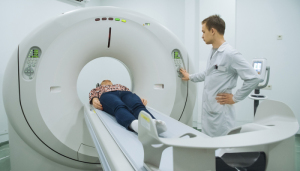por
John R. Fischer, Senior Reporter | November 10, 2017

Physicians should not diagnose axial
spondyloarthritis based on MR scans
alone, according to a new study
A series of studies indicate that physicians should be wary of relying solely on MR when diagnosing axial spondyloarthritis (axSpA) in patients.
The findings presented last week at the at the 2017 ACR/ARHP Annual Meeting in San Diego suggest that MR scans of the sacroiliac joints are prone at times to produce positive results for axSpA in healthy individuals who do not have the condition, ushering in the need for additional diagnostics to confirm the presence of the condition.
“Only recently have we realized that there is a lot of diagnostic ‘overcall’ regarding MR of the sacroiliac joints,” Robert B.M. Landewé, a professor of rheumatology at the University of Amsterdam in the Netherlands and the lead author of one of the studies, told HCB News. “In addition, physicians tend to value a positive MR test result as proof for the presence of spondyloarthritis. Such a strong belief is only justified if healthy individuals do not have positive MRs but increasing evidence suggests that healthy people may score positive.”



Ad Statistics
Times Displayed: 194156
Times Visited: 5654 For those who need to move fast and expand clinical capabilities -- and would love new equipment -- the uCT 550 Advance offers a new fully configured 80-slice CT in up to 2 weeks with routine maintenance and parts and Software Upgrades for Life™ included.
Healthy patients who receive a positive MR finding for axSpA may incur harm from exposure to expensive and potentially toxic biologicals used to treat the condition.
The study involving Landewé consisted of three trained, blinded readers scoring MR scans of 47 healthy individuals, 47 gender- and age-matched participants with confirmed cases of axSpA, 47 age- and gender-matched back pain patients irrespective of MR results, seven women with postpartum back pain lasting several months and 24 frequent runners.
AxSpA patients were selected from the SPondyloArthritis Caught Early (SPACE) cohort. MR scans were scored on the basis of the Assessment of Spondyloarthritis (ASAS)/Outcome Measures in Rheumatology (OMERACT) and the Spondyloarthritis Research Consortium of Canada (SPARCC) definitions, with SPARCC scores being the mean result of the three readers.
The presence or absence of bone marrow edema (BME) was agreed upon by the three in 75.6-79.9 percent of cases. Eleven healthy individuals were found to have positive MRs compared to forty-three of the axSpA patients and three chronic back pain participants. Three runners and four women with postpartum back pain had positive MR results for sacroiliac, an inflammation of one or both sacroiliac joints that can be associated with axSpA.
SPARCC scores among the three also correlated well with mean results of 1.7 for healthy participants, 20.9 for positive axSpA patients, 0.8 for chronic back pain patients, 0.8 for frequent runners and 4.5 for women with postpartum back pain.

